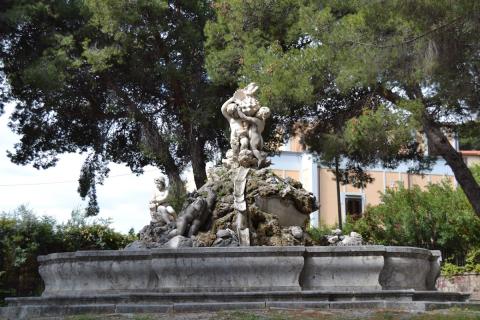Going up the panoramic Rocca-Monreale road built in the 18th century at the behest of Archbishop Monsignor Francesco Testa, one can admire the fountains located along the route, with their symbolic content and the intense iconographic message conveyed by the waters, mountains, shells and other decorative elements that more or less refer to concepts of fertility, abundance and regeneration. On the slopes of Monte Caputo, 300 metres above sea level, stands the Norman town that grew slowly during the late Middle Ages around the Benedictine Abbey and the Monumental Cathedral (Santa Maria La Nuova 1174 and 1176).
The Fisherman's Fountain, located after the Rocca, or fortress, is made of white marble and stone. Due to the elegance of its lines, the fountain is to be regarded as one of the best sculptural compositions by the artist Ignazio Marabitti, who was very skilful in giving liveliness and harmony to the cherubs. The basin is polygonal in shape and there is a stone “rock” in the centre, on top of which are three cherubs entangled with four fish, supported by a large shell. Another “rock” inside the same basin bears another cherub holding a fishing rod. The monumental fountain is also adorned with other cherubs and a marble plaque, upon which verses are engraved inviting passers-by to quench their thirst and enjoy the shade.
A little further on is the Dragon Fountain, so called because the head of a dragon sprouts from the rock, from whose mouth water gushes forth. This work was also performed by the sculptor Ignazio Marabitti, who was skilful in using the resources of the site and managed to create a rather striking scenic effect. An elegant staircase departs from the central basin, while the platform area is defined by a long seat with a baroque-style backrest. Cherubs are arranged in a pyramid shape around the head of the dragon. Under the feet of a cherub is a white marble plaque whose verses extol the usefulness of water.
A little further on is the Fontana ad Emiciclo, commonly known as the Fontana dell'Albergo dei Poveri, a building commissioned by Archbishop Benedetto Balsamo in 1834 to house the city's poor. The 18th century fountain is neoclassical in style and is made of marble and stone. It is semicircular in shape and consists of a central aedicule containing a figurehead from which water flows, then descending into a large basin embellished with floral friezes. The fountain is flanked by a hemicycle bench in the back of which is a series of frescoes and decorations. Before arriving in the town's main square, we find the Aedicule Fountain on the right dating from 1665, located near the opening of Via Benedetto D'Acquisto and Via Palermo. It is enclosed in a niche, above which is a plaque depicting three coats of arms. From the highest part of the dome, water pours first into a small round basin and then into a further larger basin, supported by marble friezes.
The beautiful Triton Fountain is in the centre of Piazza Vittorio Emanuele. The marble basin has a circular shape. In the centre is a figure of a man, “Triton”, standing on the rocks. With a heroic gesture and superhuman strength, he overcomes the fury of the dragons emerging from the waters and tramples them under his foot. The work symbolises the victory of man over brute forces. It was made in 1881 by the Palermo sculptor Mario Rutelli.
Source: Pro Loco
